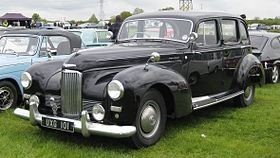Humber Super Snipe Mark I to IV
| 1945-1959 | |
|---|---|
 |
|
| Overview | |
| Production | 1945-1958 production 3909 (Mk I) 8,361 (Mk II) 8,703 (Mk III) 17,993 (IV) |
| Body and chassis | |
| Body style | 4-door saloon drophead coupe estate car |
| Powertrain | |
| Engine | 4086 cc Straight-6 side valve (I to III) |
| Dimensions | |
| Wheelbase | 114 in (2,896 mm) (I) 117 in (2,972 mm) (I to III) |
| Length | 180 in (4,572 mm) (I) 187 in (4,750 mm) (II) 191 in (4,851 mm) (III) |
| Width | 69 in (1,753 mm) (I) 74 in (1,880 mm) (II & III) |
In 1946, post-war civilian production resumed and the Super Snipe evolved though several versions, each designated by a Mark number, each generally larger, more powerful, and more modern, until production ended in 1957 with the Mark IVB version.
Mk I
The Mark I was essentially an enlarged version of the 1945 Humber Hawk, itself a facelifted pre-war car. A version of the 1930s Snipe remained available, with the 1936-introduced 2731 cc engine. However, the standard Super Snipe engine was the 4086cc side-valve engine that had appeared in the Humber Pullman nearly a decade earlier, in 1936, and which would continue to power post-war Super Snipes until 1952. Throughout the years 1936 - 1952 the maximum power output of the engine was always given by the manufacturer as 100 bhp at 3400 rpm.
Mk II
For the 1948 Mark II the body was updated, headlights fitted into the wings and running-boards re-introduced. Transverse-spring independent suspension, first introduced on the Snipe and Pullman in 1935, continued to be used. A few drophead coupés were made by Tickford in 1949 and 1950. The smaller-engined Snipe was discontinued. Early Mark II Super Snipes can be distinguished by round lamps below the head lamps.The left one was a fog lamp,and the right one was a "by pass" lamp. These were dropped in 1949 in favour of rectangular side lamps which were continued in the Mark III.
Mk III
The Mk III followed in 1950 and was externally very similar but had a Panhard rod added to the rear suspensionwhich limited sideways movement of the rear wheels and so permitted the use of softer springs. The 1950 car can be readily distinguished from the previous model by the simpler dome-shaped bumpers and the rectangular stainless-steel foot-treads on the running-boards.
A Mk III tested by The Motor magazine in 1951 had a top speed of 81.6 mph (131.3 km/h) and could accelerate from 0-60 mph (97 km/h) in 19.1 seconds. A fuel consumption of 17.7 miles per imperial gallon (16.0 L/100 km; 14.7 mpg-US) was recorded. The test car cost £1,471 including taxes.
Mk IV
The Mark IV of 1952 used a 1950 Hawk Mk IV body shell lengthened by 6 in (152 mm) but with a 4138 cc 113 bhp (84 kW) overhead-valve engine based on one from a Commer truck. Chassis and suspension components were uprated to take the greater weight and power of the Super Snipe, those parts ceasing to be interchangeable with those of the Hawk. From 1955, overdrive was available as an option, followed in 1956 by an automatic gearbox.
In 1953 The Motor tested a Mk IV and found the larger engine had increased performance with the top speed now 91 mph (146 km/h) and acceleration from 0-60 mph (97 km/h) in 14.7 seconds. Fuel consumption had increased to 15.5 miles per imperial gallon (18.2 L/100 km; 12.9 mpg-US). The test car cost slightly more at £1,481, including taxes.
